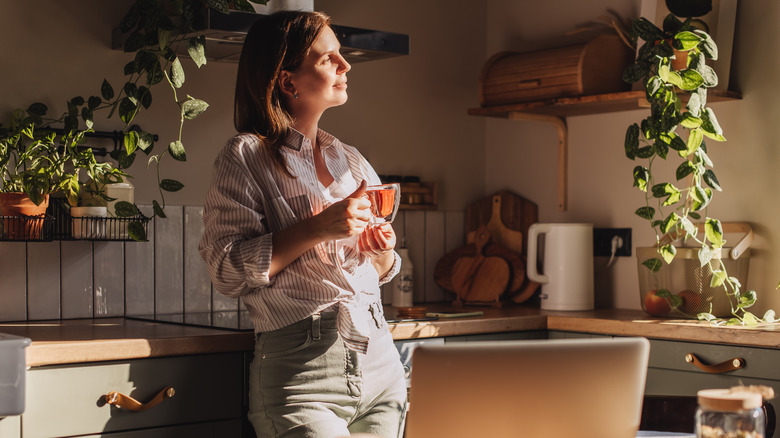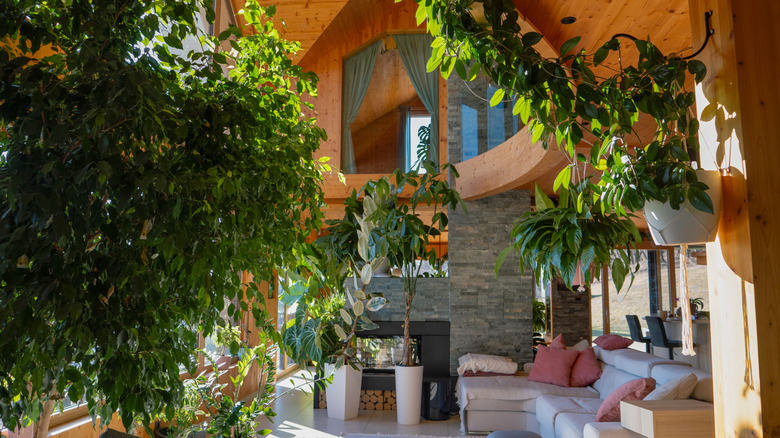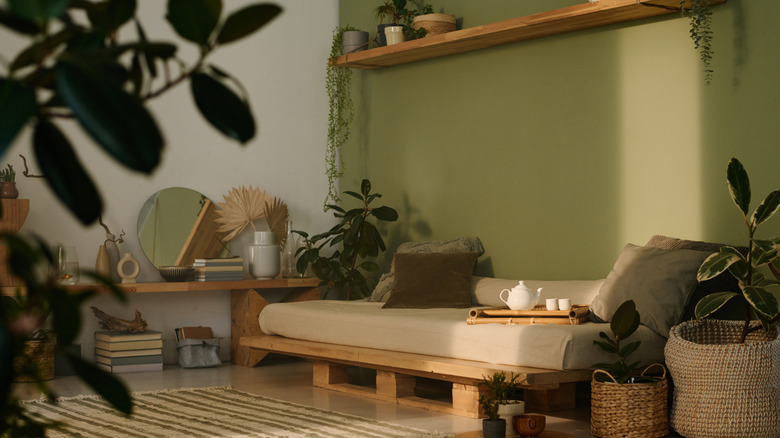The Only Home Design Style That Is Actually Proven To Make You Happier
Walking over the threshold of your house should feel like being enveloped in a blanket of safety and tranquility. We all have different ideas of what elements make up the perfect home sanctuary. Interior trends are ever-evolving and largely subjective. We may never know if minimalism is "better" than maximalism or if it's best to opt for neutral tones or vibrant colors in your home. However, there is one design style that's scientifically proven to make you happier: Biophilic design.
Biophilic design aims to capture the essence of nature and infuse it into a home's interior. According to research done by Nottingham Trent University and King Khalid University, this type of design style can actually boost your mood and even foster increased inspiration. Preliminary research also shows that it can improve physical health too, helping to alleviate adverse symptoms associated with migraine headaches and chronic pain. The thought is, since we spent a majority of human history living in and adapting to the natural world, there's some part of us that still intrinsically needs that connection. Let's dive deeper into what exactly biophilic design is and how you can implement it in your own home.
What is biophilic design?
Biophilic design draws inspiration from nature to infuse into architecture and interior design for workplaces and dwellings. It borrows colors, textures, and materials from the natural world. Stephan Kellert is one of the pioneers of this design philosophy. He drafted 6 key principles to consider: Environmental features, natural forms, natural patterns, light and space, place-based relationship, and evolved human-nature relationships. Each element explores how people are innately pulled in by nature. These principles serve as a guide on how to incorporate earthy elements into design. To understand this design style, consider how these principles work together.
Biophilic "environmental features" build the framework for how to foster a sense of connection with nature. It introduces concepts such as colors, water, air and sunlight, as key features to incorporate. "Natural forms" speak to the different shapes often seen in nature, such as spirals and oval forms. "Natural patterns" encourage a seamless blend of the sights and sounds of nature in a design. "Light and space" expands on the importance of natural, diffused light sources. "Place-based relationship" emphasizes how the physical elements of an environment should work in tandem to cultivate a cohesive spirit in order to establish a close relationship with its inhabitants. Finally, "evolved human-nature relationship" drives home the point that biophilic design should forge a sense of safety and serenity just as nature does.
How to achieve biophilic design in your home
Tapping into the benefits of biophilic design is attainable whether you're a homeowner or a renter. There are plenty of structural, permanent changes you can make to a dwelling based around natural elements such as floor to ceiling windows or rounded wall corners. But it's often just as effective to lean on nature-inspired decor to bring the spirit of biophilic design into your home. Think back to the key principles of "environmental features", "natural forms", and "natural patterns". Each of these key concepts draw from the imagery of nature. Think rounded, diffused, and earth-toned components when shopping around for decor.
Bring biophilic design into your home by selecting pieces that remind you of nature. Keeping houseplants is one fairly attainable way to invite Mother Nature into your home. Lighting also plays a massive role in achieving this style. Instead of harsh overhead light, lean on diffused, secondary light sources with warm bulbs. Purchase decor items made from wood, stone, and other natural materials. You can apply these principles in every room of your home. Tying your inner world with nature is an excellent way to put your nervous system at ease and boost your mood. So whether you're on team minimalist or team maximalist, biophilic design is a tried and true design style we can all benefit from.


